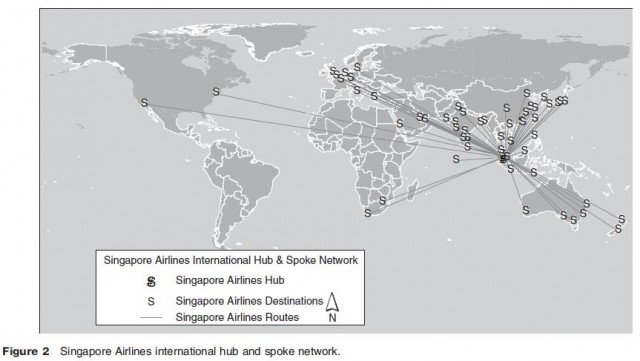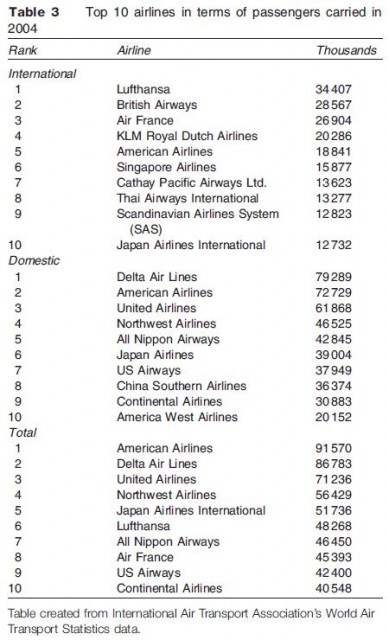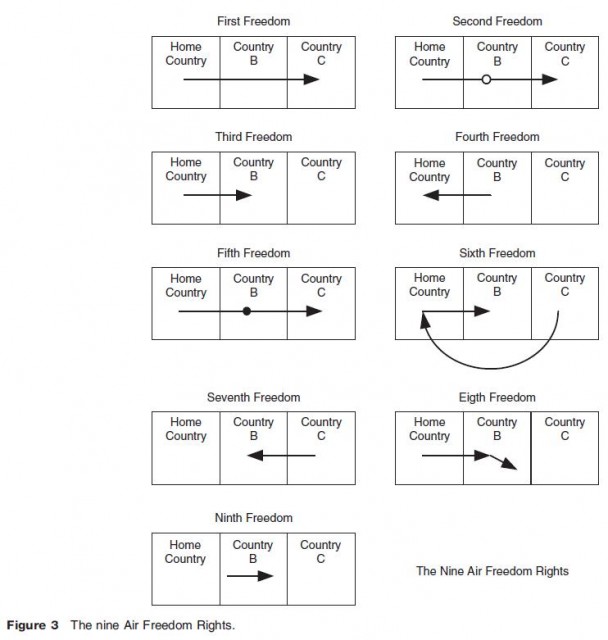Airlines
The early international airlines began their services through the mandate of national governments and were used, in the case of some European countries, to serve and reach outlying colonial outposts. It was the location of these outposts and colonial holdings that dictated the early linear networks operated by these international airlines. Early American airlines were used primarily as mail carriers and some of their geographic areas of domination today can be traced back to these mail routes.
As international air travel became more common, certain general air service agreements were reached between international governments. The first five of these air freedom rights, shown in Figure 2, were decided upon in the Chicago Convention of 1944. The First Freedom is simply the authorization to fly over another country's territory while on route to a third country. The Second Freedom permits an airline flying from its home country to a third country to stop in another country for maintenance, fuel, or in emergencies. The Second Freedom however does not allow the carrier to pick up or discharge any passengers or cargo. Third and Fourth Freedom rights allow a carrier to carry passengers and/or cargo to and from another country. Third Freedom rights cover the outbound trip and Fourth Freedom covers the inbound journey. Fifth Freedom rights allow airlines to carry passengers from the home country to another country and then continue on to a third country with the right to pick up passengers or cargo in the intermediate country.

Subsequently, four additional air freedom rights were eventually agreed upon and it is these air freedom rights that serve as the basis of all bilateral and multilateral air service agreements between countries. These four freedoms are more complicated than the first five and are the result of the increased complexity and economic importance of international air transportation. Sixth Freedom Rights allow the carrier of a country to carry passengers between two separate countries with a stop in the airline's home country in between. The establishment of this freedom has allowed places like Amsterdam and Singapore to become important hubs sites in international air transport and allow carriers such as KLM and Singapore Airlines to become important international airlines. Seventh Freedom Rights allow a carrier to operate flights between two separate countries that do not include the home country of the operating carrier. An example of this type of practice is Emirates operating service between Auckland and Sydney. Eighth Freedom Rights, also known as 'cabotage' allow a carrier to carry passengers or cargo from the carrier's home country to another country that uses more than one stop along which passengers may be loaded and unloaded. The final air freedom is the Ninth Air Freedom, which allows a carrier from a foreign country to operate between two points in another country without having to have the flight serve the carrier's home country. This is also referred to as 'full cabotage' or complete 'open skies'.

The major airlines of the world, shown in Table 3, are headquartered in the three major air transport regions of the world – North America, Europe, and Asia. The majority of the traffic carried by North American carriers is domestic traffic, while that of the other carriers is international, though heavily focused on intraregional traffic. This is due to the geographic size of the domestic markets for most of the European and Asian carriers, which are relatively small in comparison to the domestic United States market, which accounts for 33% of all passenger air travel in the world. The largest international markets are the intra European and intra Asian markets which account for 23% and 16% of the total number of passengers carried globally. The largest market between regions is between North America and Europe, accounting for nearly 4% of all the air passengers in the world.
In the past 30 years, the air transport industry has undergone immense changes and none has had a greater impact than the gradual deregulation and liberalization of the industry. The United States led the deregulation push by deregulating its domestic market in 1978. This allowed airlines to determine for themselves the markets they would serve and the fares they would charge. Initial results of deregulation included an immediate rise in competition among existing carriers, entrance of a substantial number of new carriers, and the eventual bankruptcies of several new and old carriers. A number of different factors, both industry and nonindustry related, led to the failure of these competitors. Among the industry related factors were the relatively high labor costs of the incumbents, fleet fuel inefficiencies, and fleet mismatch in the new environment of hub and spokes, and dense markets attracting new entrants eating into the incumbents' profits.
The geographic impacts of deregulation and liberalization are seen in two major areas, types of airlines and operational systems of airlines. As deregulation and liberalization of air transport spread around the globe, a dramatic increase in the number of competitors in the market has occurred. The new airlines, usually low cost or low fare carriers, are widespread in North America and Europe and are increasing in importance and number in Asia and other regions around the world. They generally serve major metropolitan centers with service to other metropolitan centers and/or leisure/holiday destinations and are intracontinental in their geographic service range. A large number of them such as Southwest in the United States and Ryanair in Europe are extremely successful in terms of both network coverage and economic results. Part of this success is attributed to having lower costs than their larger rivals through practices such as high fleet utilization, use of secondary airports where fees and congestion are lower, and lower labor costs. These cost savings allow low cost carriers to offer lower fares to their passengers putting pressure on the legacy carriers to match or lose market share.
The hub and spoke system expanded greatly following deregulation. The larger carriers began to rely on the hub and spoke system as a way to increase the number of markets they could serve by connecting thinner markets that were not feasible for direct service through a hub. As liberalization expanded globally, the hub and spoke system took on an international scope with carriers such as Singapore Airlines and KLM using Sixth Freedom Rights to flow international passengers through their hubs (shown in Figure 3). This practice allows these carriers to be successful despite not having domestic markets of any consequence.
An additional outcome of the industry liberalization and the resulting globalization was the introduction of alliances. Alliances within the air transportation industry are defined as a set of agreements between two or more airlines to work in conjunction in a particular matter while still possessing their independence. There are nine different types of alliances that airlines can utilize: costsharing ventures, asset pools, pro rate agreements, code sharing, feeder, marketing alliance, joint ventures, integrated feeder, and equity stakes. Those of particular interest to geographers include code sharing, feeder, integrated feeder, and joint ventures.
Three major global alliances, Star Alliance, One World, and Sky Team, operate in the world today and the major airlines of the world are connected to one of the three in some form. One of the cornerstones of all three alliances is the ability of aligned carriers to participate in code sharing, an agreement between two or more airlines which allows the airline that does not operate a particular flight to put its two letter identification code on the flight of the operating carrier for the purpose of marketing and selling tickets in that particular market. Code sharing benefits not only the airlines but also their passengers and the airports they serve. Benefits include increased service options, seamless transfer of passengers and luggage between carriers, an increase in marketable city pairs, increased linkages to global markets, and the ability to circumnavigate some air service agreements. An example of code sharing is Singapore Airlines and Air New Zealand, who code share on flights from Auckland to Frankfurt. A ticket can be purchased from Air New Zealand for all legs of the journey but the actual operating carrier varies for each leg. From Auckland to Singapore, Air New Zealand operates the flight and on the Singapore–Frankfurt leg Singapore Airlines is the operating carrier.

Another form of alliance prevalent at primarily the domestic level is the feeder or integrated feeder agreement. In these agreements a carrier, generally a small one using small equipment, feeds traffic to another carrier from regional airports to the larger carrier's hub operations where they are then transferred to the larger carrier's network to reach their final destination. These types of agreements allow the larger carrier to access markets they might not be able to serve due to such issues as equipment or market size. Passengers benefit by gaining access to the air transport network and can be somewhat assured of the quality of the carrier providing service under the larger carrier's brand. The difference between feeder and integrated feeder is that the integrated feeder generally operates its service under the 'colors' of the larger carrier and rarely if at all operates its own separate service. An example of this type of agreement is Air New Zealand's agreement with Air Nelson, Mount Cook Air, and Eagle Air who all fly under Air New Zealand Link title. These carriers operate regional service in New Zealand with smaller turboprop aircraft under the Air New Zealand Airlink brand and feed regional traffic to/from hubs at Auckland, Wellington, and Christchurch.
Dedicated cargo airlines such as FedEx, UPS, and DHL are among the most successful airlines in the world. The geography of air cargo service is very similar to air passenger service with North America and Europe being the key destinations for cargo both inter and intraregional and the Asia Pacific region being the primary origin of air cargo due to its manufacturing expertise. Four of the five fastest growing airports for air cargo are in China and ten out of 20 are in Asia. The top cargo airports in the world show geographic similarities to those top passenger airports with a clear Asian influence and the emergence of smaller passenger airports in the United States having significant air cargo influence. Airports such as Memphis (FedEx's primary hub) and Louisville (UPS's primary hub) derive more of their business from air cargo services than they do passenger services. The continuing globalization of markets around the world will continue to highlight air cargo services.